The construction industry faces its biggest staffing challenge in decades. With 439,000 additional workers needed in 2025 and roughly 80-90% of contractors struggling to hire qualified workers, finding skilled labor has become a make-or-break issue for project success.
The Worker Shortage Crisis Hits Hard
The numbers don't lie. The construction industry is short about 500,000 workers with skilled trades experience, and this gap keeps growing. America needs approximately 723,000 new construction workers per year according to NAHB analysis, yet the industry can't keep up with demand.
Several factors drive this shortage:
Aging workforce retirement: Many experienced workers are leaving faster than young people enter the trades. These veterans take decades of knowledge with them that's hard to replace quickly.
Cultural shift away from trades: For years, society pushed college degrees over vocational training. This reduced exposure to construction careers and created misconceptions about lower wages and job instability.
Post-pandemic career changes: COVID-19 led many workers to reevaluate their careers. Some left construction for other industries, while others retired early.
The impact hits every level. Industry leaders warn that if the worker shortage isn't addressed, labor cost escalation will accelerate further, potentially pricing out certain projects. Projects face delays, budgets strain, and some contractors must reject work they could normally handle.

Technology Transforms Construction Hiring
Smart construction companies are turning to technology to solve staffing challenges. Generative artificial intelligence (AI) is dramatically impacting recruiting practices, but human oversight remains essential.
AI streamlines the hiring process:
Automated resume screening saves hours of manual review
Predictive algorithms identify candidates most likely to succeed
Machine learning spots patterns in employment data to forecast hiring outcomes
Digital tools help create job descriptions and screening questions
Benefits of construction recruitment technology:
Reduces time-to-hire significantly
Eliminates unconscious bias in screening
Allows recruiters to focus on relationship building
Improves candidate matching accuracy
However, human oversight remains essential to keep out bias and maintain a personalized experience for candidates. The most successful companies blend AI efficiency with human insight.
Mobile recruitment platforms are becoming essential. Construction workers often search for jobs on phones, so mobile-optimized applications and quick response times give companies a competitive edge.
Skills-Based Hiring Takes Center Stage
The construction industry is moving away from degree requirements toward skills-based hiring. 75% of high school and college-aged individuals report interest in vocational schools that offer paid, on-the-job training.
This shift makes practical sense. Many construction roles require specific technical abilities that can't be learned in traditional classrooms. Hands-on experience often matters more than formal education.
Key elements of skills-based hiring:
Focus on demonstrated abilities over credentials
Use practical assessments and work samples
Value apprenticeships and on-the-job training
Consider candidates from non-traditional backgrounds
Benefits for construction companies:
Larger talent pool to choose from
Better job performance prediction
Reduced hiring bias
Faster training and onboarding
Companies implementing skills-based hiring report finding dedicated workers who might have been overlooked under traditional degree requirements.
Flexible Work Models Reshape Construction
While construction can't go fully remote like office jobs, the industry is adapting to worker expectations for flexibility. High turnover in construction hits harder than in many other industries, making retention strategies crucial.
Flexible options in construction:
Compressed work weeks (four 10-hour days)
Flexible start times when project schedules allow
Cross-training opportunities for skill development
Clear career progression paths
Retention strategies beyond pay:
Competitive benefits packages
Safer working conditions with modern equipment
Positive company culture and team building
Recognition and advancement opportunities
Competitive benefits, safer working conditions, clear career progression, and positive company culture all play a role in convincing valued construction employees to stay for the long haul.

Automation Augments Human Workers
The rise of robotics and automation is a double-edged sword for construction staffing. While technology can't replace skilled tradespeople, it's changing how they work.
Technology integration includes:
Drones for site surveying and safety monitoring
3D printing for certain building components
Robotic equipment for repetitive tasks
Digital tools for project management and communication
Impact on workforce needs:
Growing demand for tech-savvy tradespeople
Need for training on digital collaboration tools
Emphasis on adaptability and continuous learning
Higher-value activities for human workers
Automation isn't about replacing construction workers, it's about augmenting the workforce and redirecting human effort to higher-value activities.
Safety and Compliance Drive Hiring Decisions
Construction companies increasingly prioritize safety-conscious workers and compliance expertise. Safety regulations and compliance requirements in the construction industry are stringent.
Safety-focused hiring practices:
Thorough safety training requirements
Background checks and drug testing
Certification verification processes
Ongoing safety education programs
Compliance considerations:
Up-to-date knowledge of labor laws
Understanding of environmental regulations
Proper licensing and certification tracking
Documentation and reporting requirements
Companies that invest in safety training and compliance see fewer accidents, lower insurance costs, and better project outcomes.
Diversity Initiatives Expand Talent Pools
There is an increasing recognition of the importance of diversity and inclusion in the construction industry. Smart companies are actively working to attract underrepresented groups.
Diversity recruitment strategies:
Partnerships with women in construction organizations
Outreach to minority communities and schools
Inclusive job descriptions and marketing materials
Mentorship programs for new workers
Benefits of diverse teams:
Broader range of perspectives and problem-solving approaches
Better reflection of community demographics
Access to previously untapped talent sources
Improved company reputation and culture
Frequently Asked Questions
Q. What's causing the construction worker shortage?
A. An aging workforce with many experienced workers retiring, fewer young people entering the trades, and shifting priorities post-pandemic.
Q. How many construction workers are needed?
A. The Associated Builders and Contractors projects that the construction industry needs 439,000 additional workers by 2025.
Q. What skills are most in demand?
A. Specialized skills in areas such as green construction, renewable energy, sustainable building practices, and advanced technologies.
Q. How is technology changing construction hiring?
A. AI and machine learning are being integrated into construction recruitment to efficiently analyze resumes and predict hiring success.
Q. What's the average construction worker salary?
A. Average hourly wages in construction have increased 4.3% over the last year, with average hourly earnings of $38.30.
Q. How can companies improve worker retention?
A. Focus on competitive wages, benefits, safety, career development opportunities, and positive workplace culture rather than just pay increases.
Q. Are construction jobs becoming more technical?
A. Yes, workers increasingly need comfort with digital tools, drones, robotics, and modern project management systems.
Q. What role does safety play in hiring?
A. Safety training and compliance knowledge are becoming essential requirements, with companies prioritizing workers who understand modern safety protocols.


